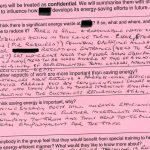Ended soon
Six years or so ago I was asked to help with an energy awareness and motivation campaign at a major conference and banqueting venue. One of the elements I was responsible for was the initial attitude survey, and I decided to approach it in a slightly unusual way, inspired by two textbooks* that I use in training workshops.
There were a couple of psychological phenomena that I wanted to exploit. One was ‘social proof’, the tendency of individuals to act in a way that they think other people like them would act in the same circumstances; the other was the power of informal friendship groups, which tend to bind people more closely than any formal organisational relationships. Also, given that I was dealing with waiters, porters, cleaners, cooks and security guards, I knew from experience that an on-line survey (fashionable at the time) was not the way to go because many of them would not have been able or willing to respond that way. It had to be paper.
Furthermore I wanted to get away from multiple-choice questions. We all know that the reply we would choose is never offered, and I was smarting from an an earlier staff survey for the Environment Agency in Wales, in which people had bombarded the free-text comment boxes with valuable thoughts. Lots and lots of valuable thoughts. So I did two things. I made the questionnaire one page, with just four open-ended questions, and I asked people to talk through the questions with their friends and come up with group responses if they could (otherwise to report dissenting views). The four questions I asked were:
 Do you think there is significant energy waste at XXX? If so, what and where, and whose job should it be to reduce it?
Do you think there is significant energy waste at XXX? If so, what and where, and whose job should it be to reduce it?- What other aspects of work are more important than saving energy?
- If you think energy saving is important, why?
- Does anyone in the group feel they would benefit from special training to help them work in a more energy-efficient manner? What would they like to know more about?
Normally for an organisation with hundreds of staff you would never do this; you would go mad analysing the replies. But with group responses, you have numerically only a fraction of the material to sift through. You are also getting people to discuss the matter in hand, which in itself starts them on the path to engagement with the subject.
The results in this case were telling. Firstly, the vast majority of replies to the question whose job it should be to reduce energy waste said it was everyone’s. Even more striking was that every reply identified cost as a thing that makes energy important (just over half additionally mentioned the environment). Some suggested that the savings could be spent on bringing in more business, and thereby securing long-term employment. And when it came to what was more important than saving energy, the overwhelming majority said customer service. Not in a million years would I have thought of making ‘customer service’ one of the possible responses in a multiple-choice question but that was most groups mentioned. I’d like to quote one response in particular:
“Customers must receive a professional, efficient friendly service carried out by conscientious, smart, knowledgeable staff, who show pride in their working environment, resulting in customers returning again ”
So there we have it: waiters, porters, cleaners, cooks and security guards thinking like owners and managers. Furthermore, almost everyone believed there was energy waste at work (the only exception, tellingly, came in an individual response from a director). Not surprisingly lighting was seen as the main culprit, though other things got one or two mentions like the behaviour of event set-up crews.
On the strength of the consensus in the replies, I circulated a single-page summary back to all staff. I have no idea which of them had participated in the survey; the important thing was for everyone to see that their colleagues tended to share a common view which, from the overall project perspective, was positive. Social proof – their instinct to conform to perceived norms – would help us to the next step.
* the two textbooks that I recommend my students to read before workshops on motivation are: “Yes: 50 Secrets from the Science of Persuasion” by Goldstein, Martin and Cialdini, which is still in print; and “The Social Psychology of Industry” by J.A.C.Brown. First published in 1954 and now out of print, this is a difficult read which occasionally challenges our modern sensibilities, but it repays the effort.